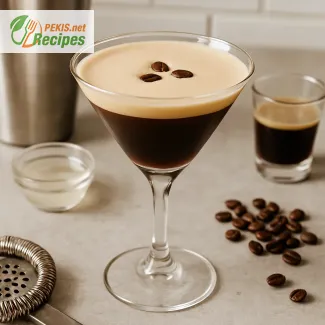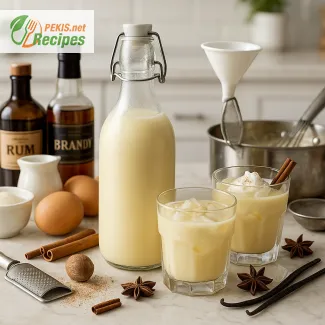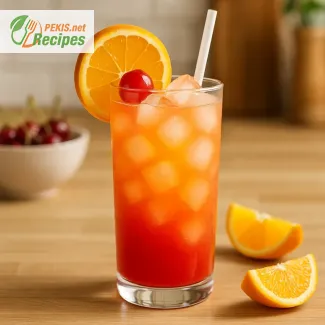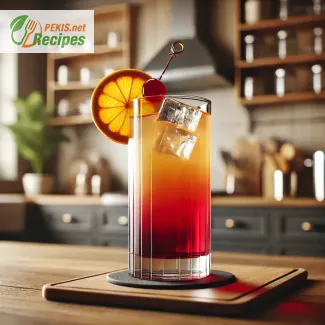
Master the Art of the Perfect Espresso Martini at Home
A velvety fusion of coffee and vodka in one elegant glass
The Espresso Martini is a modern classic that has taken the cocktail world by storm. With its silky texture, rich coffee flavor, and an energizing kick of caffeine, it's the ideal after-dinner drink or a chic party-starter. Created in the 1980s by bartender Dick Bradsell in London, the original version was requested by a model who allegedly asked for something to “wake me up and mess me up.” The result? A beautifully balanced drink that’s bold, smooth, and irresistibly luxurious.
This cocktail blends the intensity of freshly brewed espresso, the warmth of premium vodka, and the richness of coffee liqueur, usually Kahlúa or a similar brand. What makes this drink stand out is its cream-like foam layer, formed by shaking espresso with ice until perfectly chilled and aerated. The final touch is the iconic garnish—three coffee beans—symbolizing health, wealth, and happiness.
The creamy espresso martini is now a staple in cocktail bars around the world, often customized with flavored liqueurs or slight twists in texture and presentation. Whether you prefer it strong and dry or with a touch of sweetness, making it at home can be both satisfying and surprisingly simple.
Why the espresso martini is more than just a trend
In recent years, the espresso martini has surged in popularity on social platforms and drink menus alike. Its rise is fueled by the growing appreciation of craft cocktails and the global obsession with specialty coffee. Unlike many other cocktails, this one perfectly bridges the gap between coffee lovers and cocktail enthusiasts, offering a bold yet smooth drinking experience.
The beauty of the espresso martini lies in its versatility. With just a few base ingredients, it allows room for creativity and personalization. From vanilla vodka infusions to salted caramel twists, the drink adapts well to new flavors while keeping its signature profile. It also fits seamlessly into various occasions—served in sleek martini glasses for a dinner party or presented as a coffee-based dessert cocktail for special celebrations.
More than just an Instagrammable drink, the espresso martini is backed by timeless flavor combinations and an indulgent mouthfeel that make it truly satisfying. Its layered composition and bold presentation have secured its place among the world's most beloved cocktails.
Key ingredients that define a great espresso martini
Fresh espresso
Using freshly brewed espresso is critical. Avoid instant coffee or cold brew—nothing compares to the aromatic crema and bold intensity of real espresso. Ideally, the espresso should be hot when shaken, so it blends with the other ingredients and creates the signature foam on top. Quality beans with chocolate or nutty undertones enhance the depth of the cocktail.
Vodka
Opt for a high-quality vodka, as it’s the main alcoholic base. A clean, smooth spirit ensures the cocktail is balanced and doesn’t overwhelm the espresso. Many mixologists prefer neutral vodka, while others experiment with vanilla-flavored vodka to add a subtle sweetness.
Coffee liqueur
Kahlúa is the most popular choice, but there are many artisan coffee liqueurs available that bring unique characteristics—richer cacao notes, smoky finishes, or a touch of spice. Some recipes even incorporate homemade coffee liqueur for more control over the sweetness and flavor complexity.
Optional simple syrup
Some variations call for simple syrup to round out the bitterness of the espresso and alcohol. Whether you include it depends on your personal taste and the roast profile of your espresso.
Garnish: three coffee beans
Traditionally, three whole coffee beans are placed on top as a garnish. It’s not just for aesthetics—this finishing touch represents health, wealth, and happiness, a nod to Italian coffee traditions.
Shaking technique and tools that matter
Shaker and ice
A cocktail shaker filled with ice is key to achieving the creamy foam layer. The hot espresso hitting the ice helps emulsify the drink while chilling it rapidly. Shake vigorously for at least 15 seconds—this isn't just mixing; it’s aerating.
Fine strainer
To achieve a smooth, foam-topped surface without ice shards, double-straining through a fine mesh strainer is essential. This leaves you with a sleek, professional-looking finish.
Glassware
The standard vessel is a chilled martini glass, though coupe glasses are also popular. Pre-chill the glass in the freezer or with ice water before serving to keep the drink at the perfect temperature.
Variations and personal touches to elevate the flavor
Adding your own twist is what makes this cocktail shine. Here are some popular ways to customize:
- Vanilla Espresso Martini: Replace regular vodka with vanilla vodka for a smoother, sweeter touch.
- Salted Caramel Espresso Martini: Add a dash of salted caramel syrup and rim the glass with crushed caramel candy.
- Mocha Martini: Mix in a teaspoon of chocolate syrup or chocolate liqueur for a dessert-like variation.
- Spiced Espresso Martini: Infuse your simple syrup with cinnamon or cardamom for a warm and exotic flavor.
Every variation offers a new layer of complexity while keeping the cocktail grounded in its coffee-forward character.
Common mistakes to avoid for a flawless espresso martini
- Using stale or cold espresso: This results in a weak flavor and no foam. Always brew fresh.
- Not shaking hard enough: A light shake won’t produce the frothy top that defines this drink.
- Skipping the fine strain: Ice chips can ruin the silky surface.
- Over-sweetening: Too much syrup can mask the robust coffee taste. Balance is key.
The sensory experience that makes this cocktail unforgettable
From the moment the aromatic espresso hits your nose to the velvety sip that follows, every aspect of this drink is engineered to please. The texture is creamy yet crisp, the bitterness of coffee is offset by the liqueur’s sweetness, and the alcohol adds a warming depth. It’s a multisensory drink that combines visual appeal, aromatic richness, and textural contrast in one glass.
Whether you're serving guests or treating yourself, mastering the espresso martini transforms your home bar game. With just a few ingredients and the right technique, this coffee cocktail can be the highlight of any evening.
- Brew a fresh 30 ml (1 oz) shot of espresso using quality coffee beans. Let it rest for 30 seconds but don’t allow it to cool completely.
- Fill a cocktail shaker halfway with ice cubes (approx. 150 g / 5.3 oz).
- Add the vodka, coffee liqueur, sugar syrup, and hot espresso to the shaker.
- Close the shaker tightly and shake vigorously for 15–20 seconds to chill and foam the cocktail.
- Double strain the drink through a fine mesh strainer into a pre-chilled martini glass to avoid ice chips.
- Gently float 3 whole coffee beans on top of the foam for garnish.
- Serve immediately while cold and frothy.
Creative Espresso Cocktail Enhancements for a Richer, Deeper Flavor
Customizing your coffee-based cocktail for taste, texture, and elegance
While the classic espresso martini delivers a sharp kick of caffeine and alcohol wrapped in creamy smoothness, there's much room for personalization. When prepared thoughtfully, this cocktail becomes a refined sensory experience that goes far beyond the original. By making subtle changes to ingredients, ratios, and technique, you can enhance its flavor complexity, improve its nutritional value, or simply tailor it to your mood and occasion.
Upgrading the coffee base: better beans, better balance
The espresso shot is the heart of this drink. Using single-origin beans or dark roast varieties brings out deeper cocoa or spice notes that elevate the drink’s base flavor. Consider experimenting with beans from Ethiopia for floral brightness or Colombia for nutty undertones.
Instead of standard espresso, you can also try:
- Cold brew concentrate for a less acidic, smoother drink
- Double ristretto for a denser body and lower water content
- Nitro espresso for extra froth and a silky finish without extra shaking
These alternatives affect the foam layer and mouthfeel—cold brew reduces crema but increases smoothness, while nitro shots produce naturally creamy textures.
Rethinking the vodka: infused and premium options
Classic vodka serves as the neutral foundation, but replacing it with infused spirits adds complexity. Try:
- Vanilla vodka for a sweeter, dessert-like profile
- Espresso-infused vodka for a double-coffee hit
- Hazelnut or almond vodka for nutty depth
Choosing small-batch or artisanal vodka brands can also improve smoothness and remove unwanted alcohol sharpness. For a lower-alcohol version, swap out part of the vodka for cold brew liqueur.
Exploring beyond traditional coffee liqueurs
While Kahlúa is a go-to ingredient, using craft coffee liqueurs or homemade blends allows better control over sweetness and bitterness. A darker liqueur can add roasted undertones, while a liqueur with hints of cacao or vanilla brings a pastry-like finish.
Homemade alternatives can be made by combining:
- Cold brew concentrate
- Cane sugar syrup
- High-quality rum or brandy
- Natural extracts (vanilla, cocoa nib, cinnamon)
This allows fine-tuning the flavor to suit your preferences—less sweet, more robust, or aromatic with spices.
Sweeteners with nuance: swap simple syrup for character
Standard sugar syrup is neutral and consistent, but other options can influence the cocktail’s profile:
- Maple syrup for earthy sweetness and warm caramel tones
- Agave nectar for a lower-glycemic sweetener and mild floral notes
- Honey syrup (honey diluted with warm water) for a richer body and longer-lasting finish
- Coconut sugar syrup for a toffee-like sweetness
Each sweetener brings a different type of depth. The key is to keep the quantity balanced to maintain the espresso’s intensity.
Garnish innovation for aroma and elegance
The traditional garnish of three coffee beans symbolizes prosperity and adds a touch of class. But you can also play with presentation and aroma:
- Dust the foam with cocoa powder or cinnamon
- Float a few chocolate shavings or microplaned nutmeg for a warm scent
- Use espresso foam stencils to add shapes or patterns on the surface
These elements enhance the drinking experience, especially when paired with dessert or served at a festive gathering.
Health-conscious tweaks for a lighter cocktail
If you're looking to reduce sugar or alcohol content, several simple changes make the drink more suitable for varied dietary preferences:
- Use decaffeinated espresso for a late-night version without sleep disruption
- Replace coffee liqueur with unsweetened coffee concentrate and a touch of vanilla extract
- Reduce sweetener and rely more on natural flavorings like cacao or cardamom
- Try a low-ABV vodka substitute like botanical spirits for a less intense drink
Each of these changes subtly shifts the cocktail while keeping its core identity intact.
Common mistakes that ruin the texture and flavor
To ensure every espresso martini is smooth and delicious, avoid these frequent errors:
- Under-shaking: Without vigorous shaking, the drink won’t form the creamy foam on top
- Using stale coffee: Cold or oxidized espresso flattens the flavor
- Too much sweetener: Overpowers the espresso and reduces elegance
- Low-quality ingredients: Every element in this drink is noticeable—poor vodka or artificial syrup diminishes the whole experience
Why homemade versions shine over pre-mixed cocktails
Homemade espresso martinis allow full control over ingredient quality, flavor balance, and presentation. Bottled or bar-made versions often cut corners by using instant coffee, flavoring syrups, or pre-sweetened liqueurs, which lack the depth and freshness of a properly prepared version at home.
With attention to technique and personal preferences, this cocktail becomes a canvas for creativity. You can make it richer, lighter, bolder, or more refined, depending on the occasion. And when crafted carefully, each glass becomes more than a drink—it becomes a statement of taste.
Allergens and gluten content:
- This recipe does not contain gluten by default.
- Contains caffeine (from espresso) and may contain traces of allergens from coffee liqueur (check label: some brands may contain nuts or dairy derivatives).
Allergen substitution tips:
- If allergic to caffeine, replace espresso with decaffeinated espresso.
- If allergic to nuts or dairy traces in liqueur, use a homemade coffee liqueur based on rum, coffee, and sugar syrup.
Vitamins and minerals per serving (approximate):
- Vitamin B2 (Riboflavin): 0.1 mg – supports energy metabolism and skin health
- Magnesium: 8 mg – contributes to normal muscle and nerve function
- Potassium: 92 mg – helps maintain healthy blood pressure
- Niacin (Vitamin B3): 0.5 mg – supports the nervous system and reduces tiredness
- Iron: 0.1 mg – important for oxygen transport in blood
Antioxidants per serving (approximate):
- Chlorogenic acid: 30–40 mg – from coffee, helps reduce inflammation and supports metabolism
- Melanoidins: small amounts – contribute to antioxidant activity and gut health
- Caffeic acid: 5–10 mg – provides anti-inflammatory and cellular protection benefits
- Trigonelline: 4–6 mg – supports cognitive function and cardiovascular health
- Polyphenols (total): approx. 60–80 mg – general antioxidant benefit, supports immune defense and aging prevention




